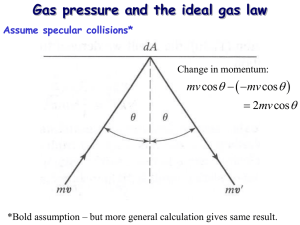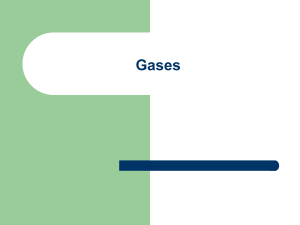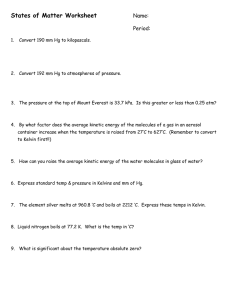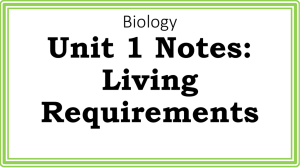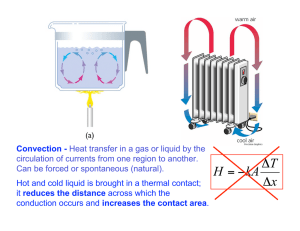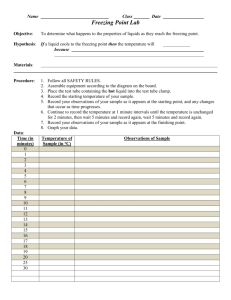Phase transitions 8.2 Temperature and Heat Phase Transitions Ideal gas Law
advertisement
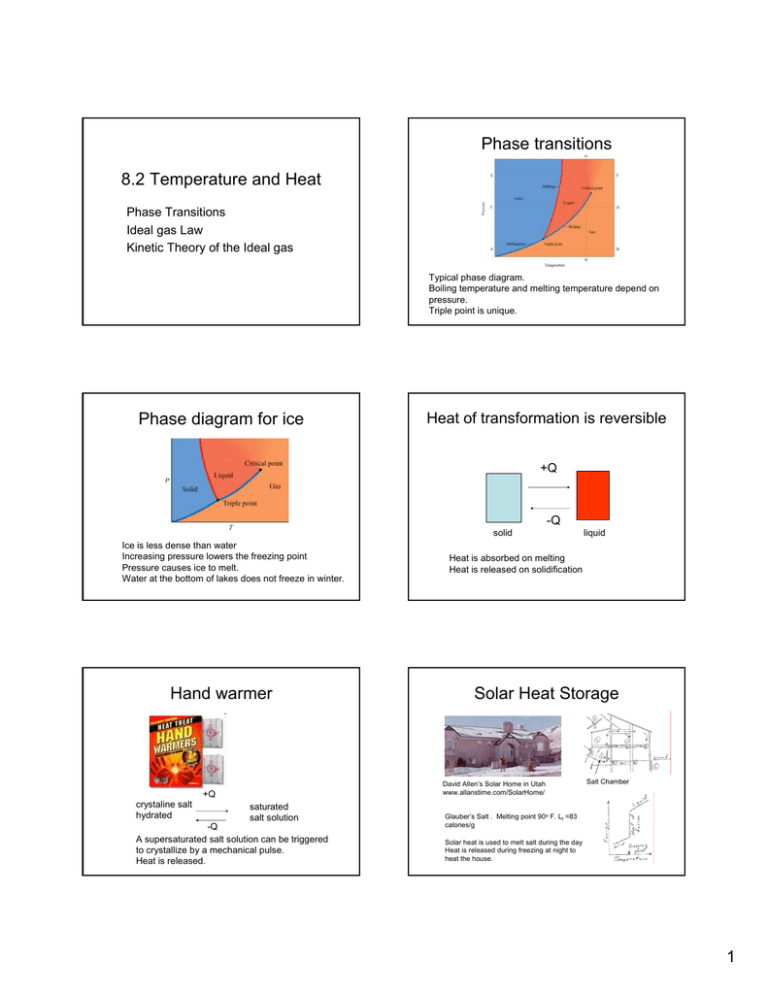
Phase transitions 8.2 Temperature and Heat Phase Transitions Ideal gas Law Kinetic Theory of the Ideal gas Typical phase diagram. Boiling temperature and melting temperature depend on pressure. Triple point is unique. Phase diagram for ice Heat of transformation is reversible +Q -Q solid Ice is less dense than water Increasing pressure lowers the freezing point Pressure causes ice to melt. Water at the bottom of lakes does not freeze in winter. Hand warmer crystaline salt hydrated Heat is absorbed on melting Heat is released on solidification Solar Heat Storage David Allen’s Solar Home in Utah www.allanstime.com/SolarHome/ +Q saturated salt solution -Q A supersaturated salt solution can be triggered to crystallize by a mechanical pulse. Heat is released. liquid Salt Chamber Glauber’s Salt . Melting point 90o F. Lf =83 calories/g Solar heat is used to melt salt during the day Heat is released during freezing at night to heat the house. 1 Heat of fusion Heat of evaporation Heat of vaporization provides energy for hurricanes. Thermal power Consider 1 inch of rain falling in an area of 1km2. Calculate the thermal energy released Q = mL v = ρAhL v = (1000kg / m3 )(103 m)2 (.025m)(2257x103 J) = 6x1013 J condensation energy equivalent to 4x105 gallons of gasoline. Heat released when water freezes can be used to save crops from freezing. evaporation Ideal Gas Law Gas Constant The ideal gas law describes be behavior of gases at different temperatures and pressures. The ideal gas law can also be written in terms of the n the number of moles of gas. PV= nRT PV= NkT Where R = NA kB = Universal Gas Constant NA = Avogadro’s number, the number of molecules in a mole=6.02x1023 n = number of moles of gas T = Temperature (K) P = pressure V= volume N= no. of molecules k = Boltzmann’s constant T=Kelvin temperture (K) k = 1.38x10-23J/K = 8.62x10-5 eV/K Properties of the idea gas P P at constant V 0 T (K) Question You are taking a road trip for the weekend. Before you start you check the pressure in your tire and the gauge reads 31lbs/in2 ( 214 kPa) and the temperature is 15o C. After a few hrs of driving you check your tires pressure again and the gauge now reads 35 lb/in2 (241 kPa). What is the temperature in the tire now? V V at constant P 0 T T (K) 2 Kinetic theory of the ideal gas Model for the ideal gas The kinetic theory of the ideal gas is a statistical mechanical theory to explain the thermodynamic properties of the gas based on the microscopic properties. We use classical Newtonian mechanics for a large number of particles in a box, to calculate the pressure. 1. All collisions are elastic, conserving energy and momentum. 2. Movement of molecules is random. No preferred direction. 3. Large # of identical molecules of mass m, no structure, no size. 4. All energy in the gas exists in form of kinetic energy of its molecules. Force at the wall Calculate the pressure Force due to all molecules The force exerted at the wall is due to the change in momentum F = ∑ fi = ∑ N Change in momentum Pressure ∆p x = 2mv x Force Fx = N P= ∆p x ∆t 2A vx time to make a round trip from wall to wall Average value of v2 Connect to the ideal gas law Magnitude of v v 2 = v 2x + v 2y + v 2z average value of v v =v +v +v 2 2 x 2 y v 2x = v 2y = v 2z or v 2 = 3v 2x v 2x = 1 2 v 3 PV = Nmv 2x becomes PV = 2 z but since no direction is special then F m 2 Nm 2 =N vx = vx A AA V PV = Nmv 2x Time between collisions with the wall ∆t = 2mv x mv 2x m =∑ = N v 2x 2A / v x A A 1 Nmv 2 3 From the ideal gas Law PV = NkT gives a microscopic value for the thermal energy 1 3 mv 2 = kT 2 2 The average kinetic energy of a gas molecule is proportional to the absolute temperature 3 Thermal speed The thermal speed is dependent on T and the mass of the molecule. v th = 3kT m Question Find the kinetic energy of a N2 molecule at 300 K in eV (1eV= 1.6x10-19 J). Ideal gas For 2 gas samples with different molecular masses at the same temperature T • The kinetic average energy of the gas molecules are equal • The average velocities of the gas molecules are different. The gas with the larger mass has a slower velocity • The kinetic energy increases linearly with the absolute T. Question Compare the thermal velocities of a molecule of N2 and He (Molecular mass 28 g/mole, 4 g/mole) at 300K It is useful to remember that the value of kT at room temperature is ~25 meV Question Compare the thermal velocities of a molecule of N2 and He (Molecular mass 28 g/mole, 4 g/mole) Maxwell-Boltzmann distribution ⎛ m ⎞ 2 −mv 2 / 2kT N( v )∆v = 4πN⎜ ∆v ⎟v e ⎝ 2πkT ⎠ N(v) no. of molecules with speed v. Distribution Goes through a maximum Depends on Temperature 4 Question Room temperature (about 293 K) is only about 6.5% higher than a typical refrigerator temperature (275 K). Yet in a refrigerator the rate of typical chemical and biological reactions is greatly reduced. To show the importance of the high energy tail of the MaxwellBoltzmann distribution in food spoilage calculate the ratio of the no. of oxygen molecules with a speed of 1350m/s -1351 m/s at 293 K and 273 K. How does it compare to the 6.5% increase in T. 5
